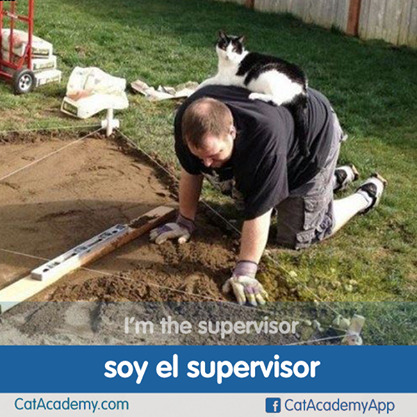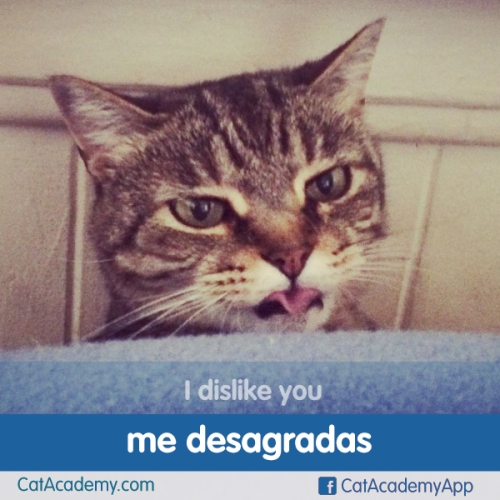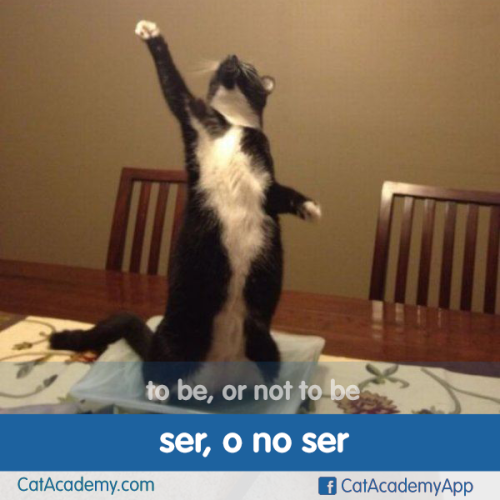#language learning app
Warmest purrs,
Mousha, Cat Academy CEO
Post link
Like you, one human, two languages! With a little help from us, of course.
http://is.gd/Cat_Spanish
Post link
A handy phrase for those of you that have smaller humans under your command.
http://is.gd/Cat_Spanish
Post link
¡Esa es la cuestión! (Round of applause for Shakespeare cat, por favor.)
http://is.gd/Cat_Spanish
Post link
Bouncer cat doesn’t fool around when it comes to enforcing the no-pictures policy!
http://is.gd/Cat_Spanish
Post link
Interview with Gabe Wyner from Fluent Forever

Today we are going to talk to Gabe Wyner from Fluent Forever about his app project.
1. Tell me a little about you.
I’m a 34-year-old author
, living in Chicago with my wife and dog. I was born in Los Angeles and grew up as a nerdy kid obsessed with video games and science. I sang musical theater and classical music as a hobby, and in college, I got dual majors in opera and mechanical…
Hello, everyone! I’m breaking my short break because I was recently clued in to another language learning app, so of course I had to check it out! This app is called “Drops”, and it is a vocab builder for a pretty wide variety of languages. Is it worth it? I tested out the Korean course; this is what I think about this app.
Drops is not an app that will teach you grammar—it is strictly a vocabulary builder. Now, if you’ve read any of my other posts on learning vocabulary, you are aware that I am typically against using pre-made flashcards and vocab lists and all, for the reason that context is key for really learning a word, especially for more advanced vocabulary that can be easily confused with words of other meanings. Since this app focuses on relatively simple, concrete vocabulary, that is largely not an issue (though I still highly recommend using your own vocabulary list)!
Getting started with Hangul
Okay, so let’s look at this app from the beginning. When you start it up, you’re presented with a long list of languages you can select, and once you choose a language, you can choose beginner or intermediate level. Depending on which one you choose, different levels will be available to you. For example, if you choose “Beginner,” you can only choose from the foundation courses, or the first course of each level, including the higher level courses. If you choose “Intermediate,” over half of the levels will be totally unlocked (so you can skip around at will!), and the first course of each intermediate level is unlocked. You can switch freely between “Beginner” and “Intermediate,” so your first choice is not really important. I started with the beginner track and went into the Hangul lessons.
Before I get into talking about the lesson, let me talk about the format of this app. You click into a lesson, then you match words with pictures to move on. Each word is introduced as a “drop” with a picture and the word written in Korean, though you can see a translation if you press and hold the image. There are also spelling and writing questions mixed in as well, but the basic premise is sliding a word or syllable to the right place to move on. There is an automatic audio reading out of the words, and if you start with beginner, romanization is standard. All of this can be turned off or left on from your settings, so I immediately went to turn off the romanization. You are given five minutes of play/study time per day (unless you find a way to obtain more time… more on that later), so this is supposed to be a quick and casual usage app.
Anyway, the Hangul lessons! Unfortunately, they get it wrong from the very start. The sound files are quite nice, but they pair it with romanization (yes, I know that every Korean learning app will have romanization, but I reserve my right to complain about it!), and they include the names of the Hangul with no explanation of what it is. For example, this is what you see when ㄱ is introduced. If you don’t already know what “giyeok” is supposed to be, then you might be a bit confused.
Once you’ve matched the Hangul and romanization a few times, you’ll be instructed to write the Hangul… incorrectly. They teach ㄱ as being two strokes (and accordingly, ㄲ as four) when they are one and two strokes respectively. If you try to write ㄱ in one stroke, it says you’re wrong. This is a really lazy error, in my opinion. It’s so easy to look up proper stroke order, so why are they teaching it incorrectly?
Moving on
The Hangul section left a bad taste in my mouth after a few rounds of forcing myself to write incorrectly, so I skipped the Hangul levels for the next block in the “Foundation” group, which is “Essentials.” It starts out with simple words like “네” and “아니요”… and then you get a cheery “알겠어!” and “안녕!” followed by “감사합니다” with NO explanation of different formality levels and the proper situations in which to use all of these. If you are new to Korean, the words/sentences there are all in different formality levels, which means that some of them are very inappropriate depending on your relationship with the person you are talking to. It is a big deal in Korean, and this section left an even worse taste in my mouth than the Hangul section did, unfortunately. I understand that Drops wants to introduce what they consider useful phrases and all, but by carelessly mixing formality levels with no explanation, they do new learners a HUGE disservice.
I ran into a similar error when I checked out the emotions panel, as feelings in Korean are expressed through verbs that need to be conjugated. Again, with no explanation of the grammar, they introduce feelings in noun modifier form (ex: angry = 화난, bored = 지루한 [though that should be 심심한 if anything since 지루하다 is “boring,” but I digress]). This creates a false equivalence (at least for native English speakers) of “angry = 화난”, treating it like we would an adjective in English instead of looking at it in terms of Korean grammar.
Redeeming factor
Thankfully, once you get into things that exist independent of formality levels and conjugation (that is, nouns), there is actually a pretty good variety of words for building up vocabulary. The app covers a wide range of words classified under various themes such as “People & Health,” “Science & Wisdom,” “Society & Politics,” and more.
Pros and Cons
So now we get to the final verdict. Let’s check out some pros and cons of the app “Drops”:
Pros:
- Clean, colorful, user-friendly interface
- Option to not display romanization
- Good, clear audio files
- Useful vocabulary
- Ability to skip around a lot of the levels if you go straight to intermediate mode
- There is a “Collection” area where you can look at all the words you have learned so far
Cons:
- Incorrect Hangul stroke order
- No explanation of formality levels or grammar, just mixing up levels and giving conjugated forms as if there is a 1-to-1 equivalence with English/whatever other language
- Limited to five minutes of play/study time per day
- Popup messages asking if you want to sign in on Facebook or upgrade to premium to get more time :]
- Other popup messages telling you about other features you could get if you sign up for premium
- Images can be misleading or ambiguous. For example, the image for “감사합니다” is a person bowing, but if the learner does not know that one often bows when thanking someone else, they might not make the connection. Also, 네 and 아니요 are boxes with a check mark and an X respectively, which could reasonably lead a new learner to think the words mean “right” and “wrong” instead of “yes” or “no.” This is a small thing since you can press and hold for translations, but still something to consider.
Verdict
Drops can be a fun and easy way to review vocabulary, but it fails on some really basic points as it fails to correctly teach Hangul stroke order and mixes formality levels with no respect for their significance in speaking Korean properly. There is a pretty good variety of vocabulary if you can get past the unexplained grammatical things, but it’s a shame that you can only play for five minutes before they start hounding you to link up your Facebook or pay for their premium service. Ultimately, Drops is a visually pleasing vocab practice app that is pretty fun to fiddle with, but it fails beginners from the very start. I would only recommend this app to people who already have at least a basic understanding of formality levels and conjugation, and who know how to write Hangul correctly. Use this if you have five minutes to kill picking up or reviewing nouns, but don’t trust it to tell you anything about Korean grammar.































